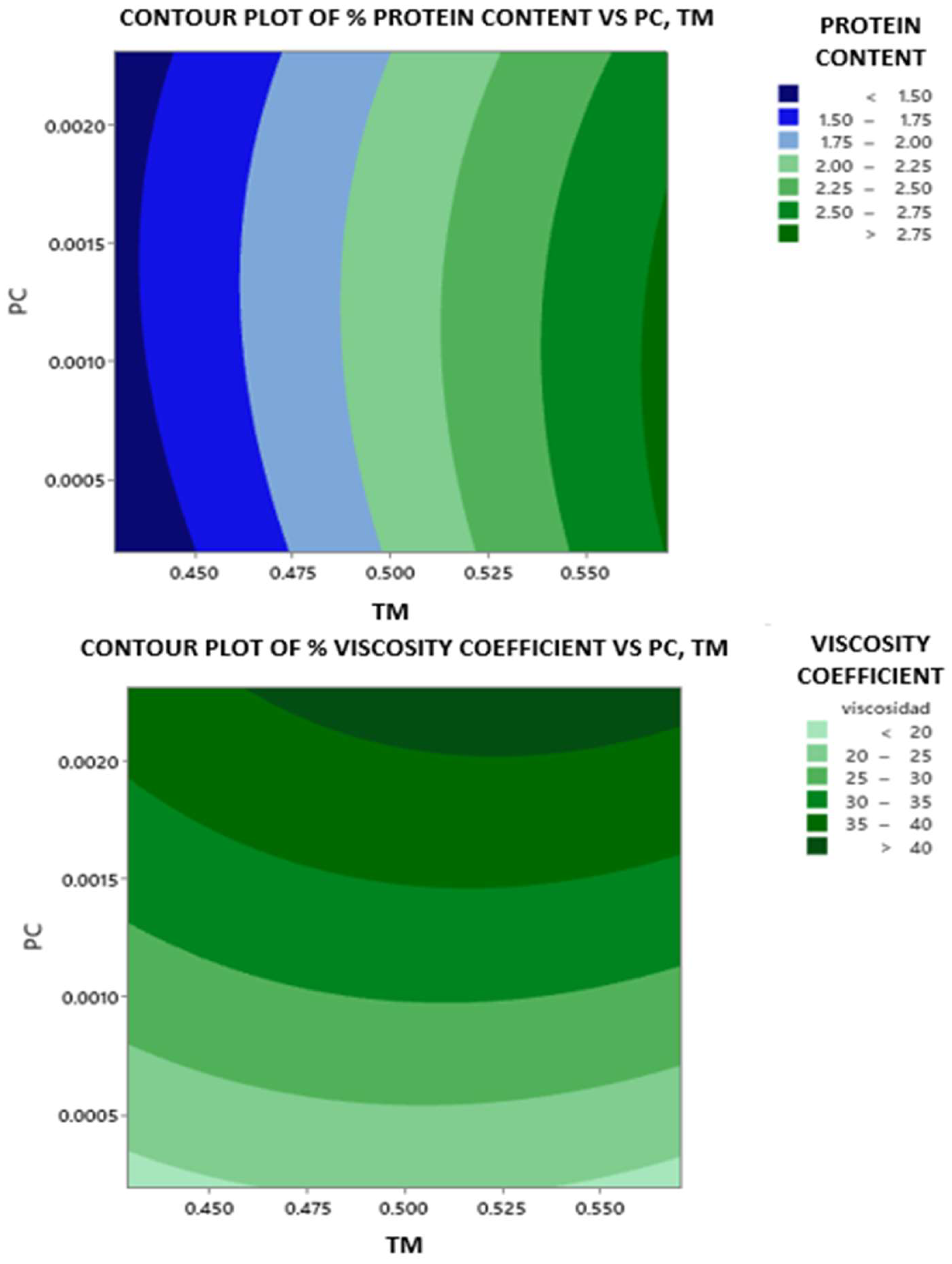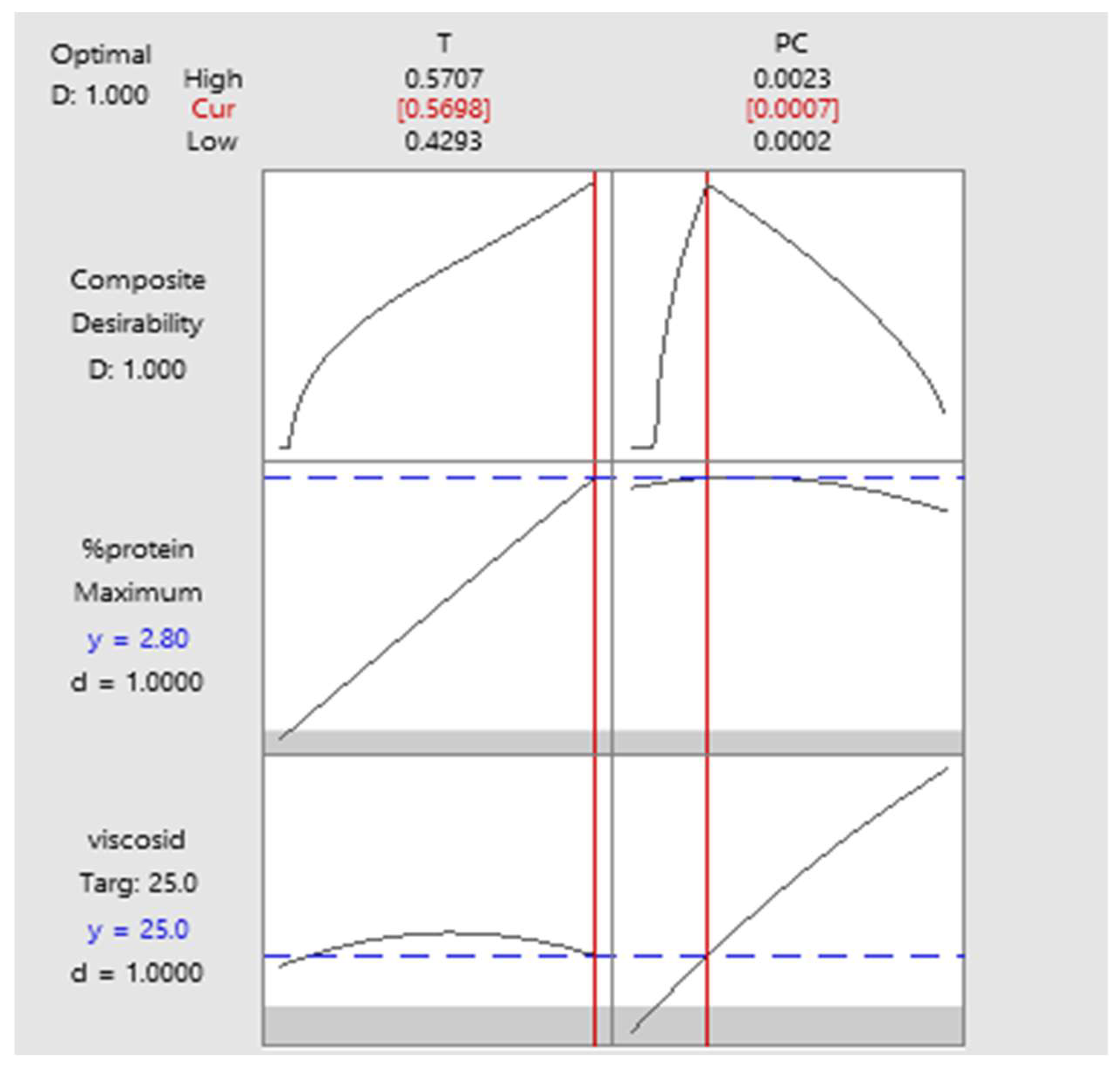Development of a Plant-Based Beverage with Tarwi (Lupinus mutabilis) Milk, Polysaccharides from Cushuro (Nostoc sphaericum), and Blueberry Extract †
Abstract
1. Introduction
2. Materials and Methods
2.1. Raw Material
2.2. Experimental Design
2.3. Development of the Beverages
2.4. Proximal Composition
2.5. Viscosity Coefficient
2.6. Antioxidant Activity
2.7. Determination of Amino Acid Profile
2.8. Sensory Analysis
2.9. Statistical Analysis
3. Results and Discussion
3.1. Design of Experiment
3.2. Physicochemical Characterization
3.3. Amino Acid Profile
3.4. Sensory Analysis
4. Conclusions
Author Contributions
Funding
Institutional Review Board Statement
Informed Consent Statement
Data Availability Statement
Acknowledgments
Conflicts of Interest
References
- Xiao, X.; Zou, P.-R.; Hu, F.; Zhu, W.; Wei, Z.-J. Updates on Plant-Based Protein Products as an Alternative to Animal Protein: Technology, Properties, and Their Health Benefits. Molecules 2023, 28, 4016. [Google Scholar] [CrossRef]
- Walther, B.; Guggisberg, D.; Badertscher, R.; Egger, L.; Portmann, R.; Dubois, S.; Rezzi, S. Comparison of nutritional composition between plant-based drinks and cow’s milk. Front. Nutr. 2022, 9, 988707. [Google Scholar] [CrossRef] [PubMed]
- Huaringa-Joaquin, A.; Saldaña, C.L.; Saravia, D.; García-Bendezú, S.; Rodriguez-Grados, P.; Salazar, W.; Camarena, F.; Injante, P.; Arbizu, C.I. Assessment of the Genetic Diversity and Population Structure of the Peruvian Andean Legume, Tarwi (Lupinus mutabilis), with High Quality SNPs. Diversity 2023, 15, 437. [Google Scholar] [CrossRef]
- Chasquibol, N.; Sotelo, A.; Alarcón, R. Development of Powdered Beverage with Cushuro (Nostoc commune) Concentrated Protein and Quinoa (Chenopodium quinoa). Biol. Life Sci. Forum. 2023, 25, 2. [Google Scholar] [CrossRef]
- Chasquibol, N.; Sotelo, A.; Tapia, M.; Alarcón, R.; Goycoolea, F.; Perez-Camino, M.d.C. Co-Microencapsulation of Cushuro (Nostoc sphaericum) Polysaccharide with Sacha Inchi Oil (Plukenetia huayllabambana) and Natural Antioxidant Extracts. Antioxidants 2024, 13, 680. [Google Scholar] [CrossRef] [PubMed]
- Jeong, Y.; Lim, W.; Yoo, B. Relationship between Syringe Flow Measurements and Viscosity of Nectar-Thick Beverages for Dysphagia Management. Foods 2021, 10, 1981. [Google Scholar] [CrossRef] [PubMed]
- Alaiz, M.; Navarro, J.L.; Girón, J.; Vioque, E. Amino Acid Analysis by High-Performance Liquid Chromatography after Derivatization with Diethyl Ethoxymethylenemalonate. J. Chromatogr. A 1992, 591, 181–186. [Google Scholar] [CrossRef] [PubMed]
- Lopes, M.; Pierrepont, C.; Duarte, C.M.; Filipe, A.; Medronho, B.; Sousa, I. Legume Beverages from Chickpea and Lupin, as New Milk Alternatives. Foods 2020, 9, 1458. [Google Scholar] [CrossRef] [PubMed]
- Fructuoso, I.; Romão, B.; Han, H.; Raposo, A.; Ariza-Montes, A.; Araya-Castillo, L.; Zandonadi, R.P. An overview on nutritional aspects of plant-based beverages used as substitutes for mow’s milk. Nutrients 2021, 13, 2650. [Google Scholar] [CrossRef] [PubMed]
- Mohammadi, M.; Mahdavi-Yekta, M.; Reihani, S.F.S.; Khorshidian, N.; Habibi, M.; Khaneghah, A.M. Assessment of Physicochemical Properties of Orange Juice Concentrate Formulated with Pectin, Xanthan, and CMC Hydrocolloids. Int. J. Food Sci. 2024, 2024, 7013553. [Google Scholar] [CrossRef] [PubMed]


| Formulation | StdOrder | RunOrder | PtType | Blocks | TM (%) | PC (%) | BE (%) |
|---|---|---|---|---|---|---|---|
| F1 | 1 | 1 | 1 | 1 | 45.00 | 0.05 | 54.95 |
| F2 | 2 | 2 | 1 | 1 | 55.00 | 0.05 | 44.95 |
| F3 | 3 | 3 | 1 | 1 | 45.00 | 0.20 | 54.80 |
| F4 | 4 | 4 | 1 | 1 | 55.00 | 0.20 | 44.80 |
| F5 | 5 | 5 | −1 | 1 | 42.93 | 0.13 | 56.94 |
| F6 | 6 | 6 | −1 | 1 | 57.07 | 0.13 | 42.80 |
| F7 | 7 | 7 | −1 | 1 | 50.00 | 0.02 | 49.98 |
| F8 | 8 | 8 | −1 | 1 | 50.00 | 0.23 | 49.77 |
| F9 a | 9 | 9 | 0 | 1 | 50.00 | 0.13 | 49.87 |
| F10 | 10 | 10 | 0 | 1 | 50.00 | 0.13 | 49.87 |
| F11 | 11 | 11 | 0 | 1 | 50.00 | 0.13 | 49.87 |
| F12 | 12 | 12 | 0 | 1 | 50.00 | 0.13 | 49.87 |
| F13 | 13 | 13 | 0 | 1 | 50.00 | 0.13 | 49.87 |
| Formulation | TM(%) | PC (%) | BE (%) | Protein (%) | VC (mPa·s) |
|---|---|---|---|---|---|
| F1 | 45.00 | 0.05 | 54.95 | 1.43 ± 0.04 | 23.32 ± 0.07 |
| F2 | 55.00 | 0.05 | 44.95 | 2.57 ± 0.02 | 23.44 ± 0.09 |
| F3 | 45.00 | 0.20 | 54.80 | 1.46 ± 0.03 | 37.58 ± 0.12 |
| F4 | 55.00 | 0.20 | 44.80 | 2.49 ± 0.01 | 39.56 ± 0.06 |
| F5 | 42.93 | 0.13 | 56.94 | 1.59 ± 0.02 | 29.05 ± 0.03 |
| F6 | 57.07 | 0.13 | 42.80 | 2.80 ± 0.03 | 31.31 ± 0.05 |
| F7 | 50.00 | 0.02 | 49.98 | 2.09 ± 0.02 | 20.52 ± 0.08 |
| F8 | 50.00 | 0.23 | 49.77 | 2.08 ± 0.02 | 41.67 ± 0.04 |
| F9 | 50.00 | 0.13 | 49.87 | 2.05 ± 0.01 | 32.56 ± 0.02 |
| F10 | 50.00 | 0.13 | 49.87 | 2.10 ± 0.03 | 32.33 ± 0.01 |
| F11 | 50.00 | 0.13 | 49.87 | 2.14 ± 0.02 | 31.42 ± 0.12 |
| F12 | 50.00 | 0.13 | 49.87 | 2.16 ± 0.04 | 32.43 ± 0.07 |
| F13 | 50.00 | 0.13 | 49.87 | 2.17 ± 0.02 | 35.30 ± 0.05 |
| Variable | Equation |
|---|---|
| Protein content | y= −3.60 + 11.7 TM + 612 PC − 1.1 TM × TM − 102444 PC × PC − 733 TM × PC |
| R2 = 95.85% | |
| p-value = 0.000 | |
| Viscosity coefficient | y = −103.7 + 490 TM + 7294 PC − 7294 PC − 492 TM × TM − 1375447 PC × PC + 12382 TM × PC |
| R2 = 98.85% | |
| p-value = 0.000 |
| Sample | Protein Content (%) | Viscosity Coefficient (mPa·s) | pH | °Brix | Ash (%) | DPPH (µg Trolox/g Beverage) |
|---|---|---|---|---|---|---|
| PBB + PC | 2.72 ± 0.12 a | 23.05 ± 0.09 a | 4.49 ± 0.2 a | 2.5 ± 0.24 a | 0.03 ± 0.01 a | 1098.98 ± 63.48 a |
| PBB + CMC | 2.36 ± 0.15 b | 21.04 ± 0.13 b | 4.3 ± 0.13 a | 2.3 ± 0.31 a | 0.02 ± 0.02 a | 746.44 ± 32.98 b |
| Amino Acids | PBB + PC (mg AA/g Protein) | PBB + CMC (mg AA/g Protein) | FAO/WHO (mg AA/g Protein) |
|---|---|---|---|
| Aspartic acid | 24.19 ± 1.51 a | 22.36 ± 1.79 a | |
| Glutamic acid | 35.14 ± 15.00 a | 33.63 ± 1.10 a | |
| Serine | 44.23 ± 1.23 a | 44.52 ± 3.79 a | |
| Histidine | 22.11 ± 2.00 a | 33.45 ± 4.37 b | 15 |
| Glycine | 20.00 ± 10.22 a | 18.15 ± 2.90 a | |
| Threonine | 56.15 ± 35.89 a | 55.65 ± 4.04 a | 23 |
| Arginine | 16.99 ± 7.04 a | 13.97 ± 1.77 a | |
| Alanine | 14.51 ± 1.82 a | 16.04 ± 4.36 a | |
| Proline | 33.76 ± 21.18 a | 32.85 ± 2.35 a | |
| Tyrosine | 45.43 ± 14.59 a | 45.61 ± 13.43 a | 38 |
| NH3 | 34.30 ± 4.59 a | 34.56 ± 1.54 a | |
| Valine | 32.22 ± 14.27 a | 32.97 ± 12.73 a | 39 |
| Methionine | 32.17 ± 13.13 a | 32.16± 13.24 a | 22 |
| Cysteine | 25.78 ± 17.01 a | 26.71 ± 4.70 a | |
| Isoleucine | 17.14 ± 1.23 a | 44.80 ± 4.24 b | 30 |
| Leucine | 42.33 ± 4.69 a | 28.37 ± 2.77 b | 59 |
| Phenylalanine | 45.09 ± 11.18 a | 35.05 ± 4.61 b | |
| Lysine | 58.08 ± 12.71 a | 56.42 ± 5.90 a | 45 |
| Tryptophan | 15.03 ± 3.57 a | 13.26 ± 6.47 a | 6 |
Disclaimer/Publisher’s Note: The statements, opinions and data contained in all publications are solely those of the individual author(s) and contributor(s) and not of MDPI and/or the editor(s). MDPI and/or the editor(s) disclaim responsibility for any injury to people or property resulting from any ideas, methods, instructions or products referred to in the content. |
© 2024 by the authors. Licensee MDPI, Basel, Switzerland. This article is an open access article distributed under the terms and conditions of the Creative Commons Attribution (CC BY) license (https://creativecommons.org/licenses/by/4.0/).
Share and Cite
Calderón, S.; Bañón, R. Development of a Plant-Based Beverage with Tarwi (Lupinus mutabilis) Milk, Polysaccharides from Cushuro (Nostoc sphaericum), and Blueberry Extract. Biol. Life Sci. Forum 2024, 37, 22. https://doi.org/10.3390/blsf2024037022
Calderón S, Bañón R. Development of a Plant-Based Beverage with Tarwi (Lupinus mutabilis) Milk, Polysaccharides from Cushuro (Nostoc sphaericum), and Blueberry Extract. Biology and Life Sciences Forum. 2024; 37(1):22. https://doi.org/10.3390/blsf2024037022
Chicago/Turabian StyleCalderón, Santos, and Renzo Bañón. 2024. "Development of a Plant-Based Beverage with Tarwi (Lupinus mutabilis) Milk, Polysaccharides from Cushuro (Nostoc sphaericum), and Blueberry Extract" Biology and Life Sciences Forum 37, no. 1: 22. https://doi.org/10.3390/blsf2024037022
APA StyleCalderón, S., & Bañón, R. (2024). Development of a Plant-Based Beverage with Tarwi (Lupinus mutabilis) Milk, Polysaccharides from Cushuro (Nostoc sphaericum), and Blueberry Extract. Biology and Life Sciences Forum, 37(1), 22. https://doi.org/10.3390/blsf2024037022






